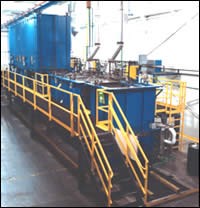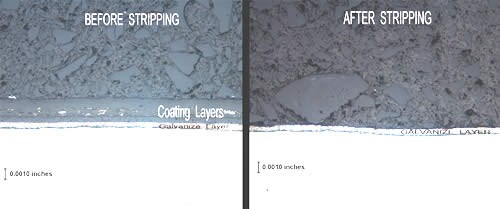New Process Doubles Productivity for Auto Supplier
Automotive OEM’s are continually looking to their suppliers for new and innovative ways to reduce costs on parts and components without sacrificing quality. The call for cost reductions, improvements and measurable contributions to the bottom line is a way of life in the manufacturing world.
The Crown Group has recently secured a contract to coat roof racks on the new Hummer H3 being introduced as a 2006 model. A necessity in finishing operations is reject management, that is, how to strip and recoat blemished components. Crown engineering and manufacturing personnel began a review of its reject parts stripping systems and found that new methods had to be found for this vital operation. They found their reclaim and salvage operations for the reject parts were having a success rate of only 30-40%. This was unacceptable to Crown and its customer.
Of particular importance was the need to improve the success rate for stripping the two major components for the new Hummer H3. Repainting the roof luggage racks color-for-color resulted in higher inventories of rejects as the parts were held until put into the production schedule again, according to Glen Ford, assistant general manager at Crown’s Ecorse, MI plant. Stripping first-time rejects eliminates the large reclaimed inventories. Inventory control would be much simpler and easier if stripping could be done in-house efficiently and effectively, Crown managers believed.
The company wanted to explore all possible production improvements and cost reduction solutions, and asked Kolene Corporation to review and analyze current systems in use. Technical, sales and service personnel assisted in the studies to determine the suitability of various cleaning and stripping systems. This was the beginning of a program that now produces a recovery success rate for reject parts in the 80-90 % range.
Historically, several workers handled pieces one at a time. Methods used for reclamation ran the gamut from spot sanding, full body sanding, repaint without sanding, finesse to a good part or stripping by thermal methods such as burn-off or stripping with traditional chemical solutions. According to Ford, Crown’s primary goals were higher recovery rates and improved part surface finish.
Sanding part defects either by full body or defect-only methods has several drawbacks. Defects can be missed, which results in painting a defect again. Also, thermal methods such as burn-off can damage substrate integrity and cause part distortion. Crown was using an outside supplier for the stripping operations and turnaround time was usually three to four days.
Working with Crown technical personnel, Kolene engineers soon found that the only viable approach was complete parts stripping. The two companies studied currently available methods, and found they were either too expensive or not suitable for the parts to be reclaimed. A new process, Recover™ 5000, was one that underwent extensive testing on the parts. Its successful performance was the motivating factor for Crown to order the complete system, according to Kolene’s Jerry Dickson.
The new process began with design, manufacture and installation of process equipment tailored to Crown’s production requirements and Kolene’s Recover 5000 cleaning solution, Dickson said. The overall stripping process was then optimized for Crown.
Recover 5000 is an organic fluid that operates from 250-325°F and can remove coatings from ferrous alloys (including galvanized steels), pot metals, aluminum and select non-metallic substrates including some plastics. Kolene says it can strip a broad range of coatings, including automotive finishes. Its use on parts and components—particularly in the automotive industry—helps to significantly reduce costs due to a number of factors.
Because the fluid causes no base metal reaction or metal loss, it allows rapid reprocessing of sensitive substrates and refinishing of rejects. No attack on polished surfaces eliminates the need for touchup. Faster cleaning cycles along with process optimization minimize turnaround time along with reducing labor and handling costs.
The Recover system offers low evaporative losses with low vapor pressure, and is readily biodegradable. Spent fluid products generally are disposed of as liquid wastes. Typically, the used Recover 5000 is classified as a non-hazardous waste, with ultimate disposal classifications made on a case-by-case basis.
The Crown Group applies a variety of coatings at its facilities, which are now stripped with the Recover 5000 process. These include electrocoat only and electrocoat with powder topcoat requiring about 30 minutes to strip. Multilayer coatings, such as electrocoat plus powder primer with 1k basecoat or with 1k basecoat/1k clearcoat, take up to an hour to strip. These stripping times represent a significant improvement over previous methods. The accompanying process flow diagram indicates the various stages in the line, where parts are moved in batches from station to station. Cycles range from 30 to 60 minutes depending on the part.
The first rinse is agitated cold water for a one minute flush. The second rinse is agitated hot water at 130°F for 30 minutes. The third and final rinse is ultrasonic hot water for 30 minutes. The ultrasonic rinse cycle is used on lapped and seamed parts or assemblies. The ultrasonic cleaning activity can penetrate into even the smallest of cavities, assuring complete removal of unwanted
materials.
Metal substrates that have been processed at Crown’s Ecorse plant include cold- and hot-rolled steel, aluminum, galvanize and galvanneal steel, and zinc and aluminum die-cast parts. Additional cost savings result as each part can use different treatment steps, according to Ford. For example, cold- and hot-rolled steel components do not have to be put through the hot water baths, but go directly from the cold-water rinses to the rust protection cycle.
Now the automated process strips hundreds of parts an hour with one worker. With the ability to quickly and completely strip coatings from reject parts, scheduling repaint time on the paint line is no longer an issue. Crown also has a 24-hour turnaround of parts at all plants, and emergency issues with rejects are resolved quickly. Since the work is done internally and based on the fixed costs of each plant, costs from outside suppliers are eliminated.
Currently, Crown Ecorse is stripping luggage rails and supports for the company’s Port Huron and Shelby, Michigan facilities, as well as its own roof rack components, window frames, bumpers, moldings and hood scoops. Studies are underway to expand Ecorse’s stripping services to other Crown facilities.
A new development of the process is treatment of plastic parts, Dickson reports. Kolene and Crown are currently evaluating stripping and recoating of plastic components. The recoated components have successfully passed applicable automotive paint test specifications.
Plastic stripping uses Recover 2000, a new fluid to strip nylon in roof racks and other automotive parts. This formula operates at low temperatures and is stripping parts with primer, basecoat and clearcoat finishes. Kolene Corporation has successfully tested the process on other nylon and TPO parts as well, Dickson said.
Related Content
Indonesian Plater Finds Fast Success in Auto Market
This father/son team, inspired by inventor Michael Faraday, focuses on anti-corrosion methods and automated processes to help their Indonesian plating business flourish.
Read MoreEpoxy Rebar Company Reinforcing Roads of the Future
Providing epoxy-coated rebar with the ultimate corrosion resistance is Simcote’s focus for the infrastructure industry it serves.
Read MoreHenry Ford Is Still Right When It Comes to Color
Who would have imagined that more than 100 years after his famous statement about any color as long as it’s black would still have relevance of a sort?
Read MoreCobot Enters Paint Industry With Safety at the Forefront
This collaborative robot is the first explosion-proof solution for the powder coating and paint arena that meets the U.S.’ stringent safety requirements. Its lead-through teach programming and tablet control are especially appealing to small shops with little proficiency in robotics.
Read MoreRead Next
A ‘Clean’ Agenda Offers Unique Presentations in Chicago
The 2024 Parts Cleaning Conference, co-located with the International Manufacturing Technology Show, includes presentations by several speakers who are new to the conference and topics that have not been covered in past editions of this event.
Read MoreDelivering Increased Benefits to Greenhouse Films
Baystar's Borstar technology is helping customers deliver better, more reliable production methods to greenhouse agriculture.
Read MoreEducation Bringing Cleaning to Machining
Debuting new speakers and cleaning technology content during this half-day workshop co-located with IMTS 2024.
Read More













.jpg;maxWidth=300;quality=90)











